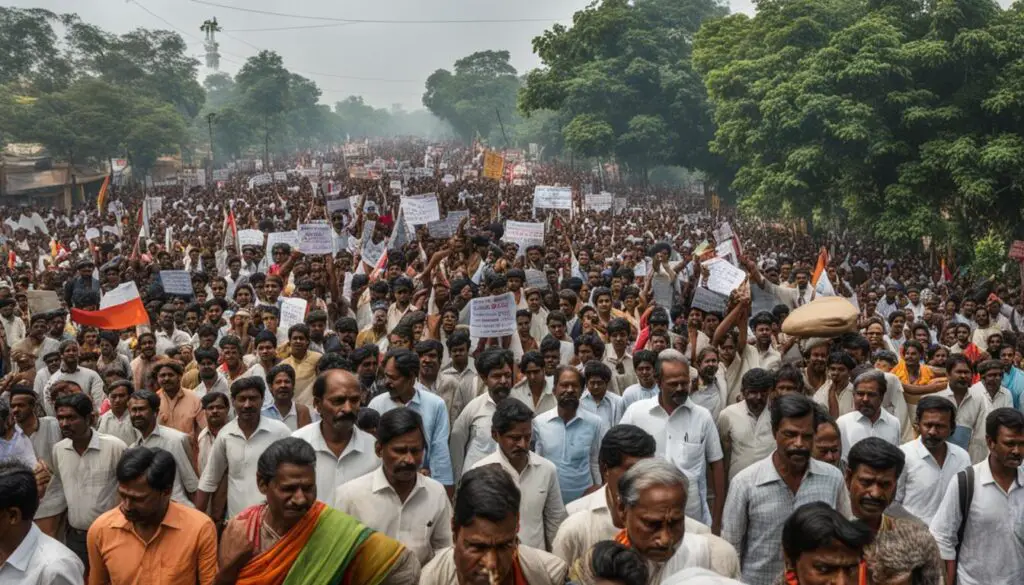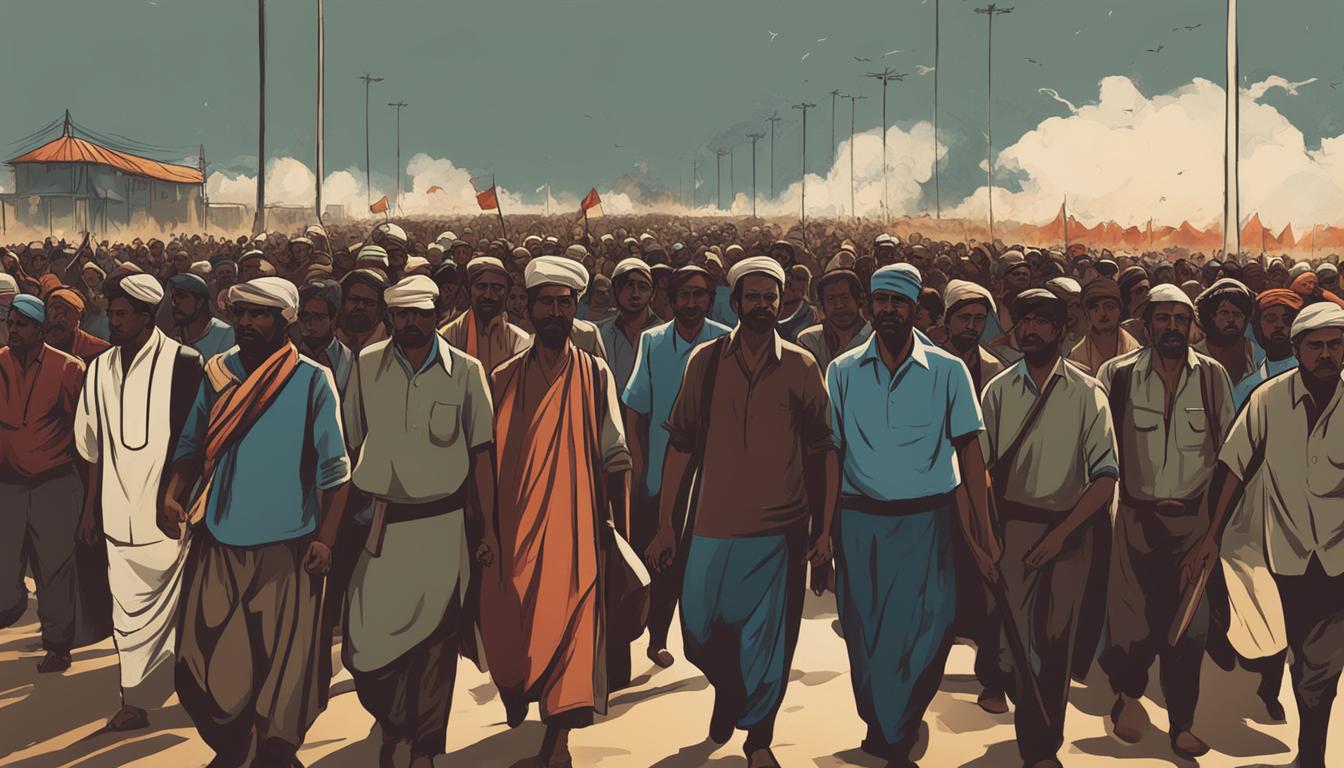Welcome to our article about the Vaikom Satyagraha, a significant movement that played a crucial role in the fight for civil rights and social equity in India. The Vaikom Satyagraha took place in the period of 1924-1925 in Travancore, now known as Kerala. This historic movement aimed to secure temple entry and the right to use public roads for all Hindus, irrespective of their caste or creed.
The caste system was deeply entrenched in Kerala society, where lower-caste Hindus faced discrimination and were denied access to temples and even restricted from walking on roads leading to the temples. Led by prominent figures such as T K Madhavan, K Kelappan, Velayudha Menon, and TR Krishnaswami Iyer, the satyagrahis initiated their first attempt to enter the Vaikom Mahadeva Temple on March 30, 1924.
Despite facing resistance and arrests by the police, the movement gained nationwide prominence and received support from influential leaders such as Mahatma Gandhi, Chatampi Swamikal, and Sree Narayana Guru. The persistent efforts of the satyagrahis, through negotiations and protests, led to a significant breakthrough.
Key Takeaways:
- The Vaikom Satyagraha was a historic movement that aimed to secure temple entry and the right to use public roads for all Hindus in Kerala.
- It challenged the prevalent caste system in Kerala, where lower-caste Hindus were denied entry into temples and prohibited from walking on roads leading to the temples.
- The satyagrahis, led by T K Madhavan, K Kelappan, Velayudha Menon, and TR Krishnaswami Iyer, made their first attempt to enter the Vaikom Mahadeva Temple on March 30, 1924, but faced resistance and arrests by the police.
- The movement gained nationwide prominence and received support from leaders like Mahatma Gandhi, Chatampi Swamikal, and Sree Narayana Guru.
- The Vaikom Satyagraha paved the way for the Temple Entry Proclamation of November 1936, allowing people from backward castes to enter Hindu temples in Travancore.
The Impact and Significance of Vaikom Satyagraha
Vaikom Satyagraha had a profound impact on the social fabric of Kerala and beyond. It paved the way for the Temple Entry Proclamation of November 1936, which allowed people from backward castes to enter Hindu temples in Travancore. The movement inspired similar temple entry movements in other parts of India, such as Suseendram, Mayiladuthurai, Guruvayur, and Madurai.
The participation of various communities and activists, including Sikhs, Christians, and Muslims, showcased the spirit of unity and solidarity in the quest for social justice. This collective effort aimed to break the chains of discrimination and ensure equal rights for all individuals. By challenging the oppressive caste system, Vaikom Satyagraha laid the groundwork for a more inclusive society.
Through peaceful resistance and nonviolent protests, the satyagrahis demonstrated the power of collective action as a means to achieve social change. The moral strength and determination displayed during Vaikom Satyagraha continue to inspire generations of activists committed to the pursuit of equality and justice.
The agitation also had political implications. It rejuvenated the morale of the Congress Party in Kerala, uniting them in the fight against social injustice. The success of the movement highlighted the effectiveness of nonviolent public protest as a strategy to challenge oppressive systems and bring about meaningful reforms.
The temple entry proclamation and the broader impact of Vaikom Satyagraha served as a catalyst for dismantling the rigid caste system and promoting the fundamental idea of human dignity and equality. It signified a step forward in establishing a more just and inclusive society, where everyone had the right to access sacred spaces and enjoy the benefits of social participation.

The Legacy of Vaikom Satyagraha
The impact of Vaikom Satyagraha extended far beyond its immediate goals. It left an indelible mark on the history of India’s struggle for civil rights and social justice.
- The movement inspired subsequent temple entry movements across the country, sparking a wave of activism that sought to dismantle barriers of caste-based discrimination.
- Vaikom Satyagraha demonstrated the power of peaceful resistance and nonviolent protests, influencing other freedom movements and providing a template for future struggles for justice.
- The momentum generated by the movement contributed to greater awareness and sensitivity towards the rights of marginalized communities, fostering a more inclusive society.
- By challenging deeply entrenched social norms, Vaikom Satyagraha paved the way for legislative reforms and policy changes that sought to dismantle institutionalized discrimination.
The legacy of Vaikom Satyagraha continues to inspire individuals and communities to stand up against injustice and fight for a more equitable society. It reinforces the belief that collective action and peaceful resistance can bring about transformative change.
Impact of Vaikom Satyagraha
| Impact | Description |
|---|---|
| Temple Entry Proclamation | Opened doors for lower-caste Hindus to enter temples in Travancore |
| Nationwide Inspiration | Spurred similar temple entry movements in Suseendram, Mayiladuthurai, Guruvayur, and Madurai |
| Unity Across Communities | Collaboration between Sikhs, Christians, Muslims, and Hindus showcased solidarity for social justice |
| Political Impact | Revitalized the Congress Party in Kerala and demonstrated the effectiveness of nonviolent protest |
| Catalyst for Change | Stimulated the dismantling of the oppressive caste system and promoted the idea of human dignity and equality |
Conclusion
Vaikom Satyagraha stands as a defining moment in the history of India’s civil rights movement. It represents a courageous challenge to the oppressive caste system and a steadfast commitment to equality and justice for all individuals, regardless of their caste or creed.
This historic movement showcased the transformative power of nonviolent resistance as a tool for social change. By adopting peaceful means of protest, the satyagrahis not only achieved their immediate goal of temple entry but also inspired future generations of activists.
The opening of the gates of the Vaikom Mahadeva Temple and the subsequent Temple Entry Proclamation were significant milestones on the path towards greater inclusivity and religious freedom in Kerala. The legacy of Vaikom Satyagraha lives on, serving as a reminder of the ongoing struggle for justice, equality, and the fundamental rights of every individual.
Today, as we reflect on the legacy of Vaikom Satyagraha, we are reminded of the importance of standing up against injustice, of breaking down barriers that divide us, and of striving for a society that respects the dignity and worth of every human being. The journey towards a more equitable and inclusive world continues, and the lessons of Vaikom Satyagraha inspire us to keep pushing for progress.
FAQ
What was the Vaikom Satyagraha movement?
The Vaikom Satyagraha was a historic movement in Travancore (modern-day Kerala) that took place from 1924-1925. It aimed to secure temple entry and the right to use public roads for all Hindus, regardless of caste or creed.
Who were the leaders of the Vaikom Satyagraha?
The satyagrahis were led by T K Madhavan, K Kelappan, Velayudha Menon, and TR Krishnaswami Iyer.
When did the Vaikom Satyagraha movement begin?
The first attempt to enter the Vaikom Mahadeva Temple was made on March 30, 1924.
Who supported the Vaikom Satyagraha movement?
The movement gained nationwide prominence and received support from leaders like Mahatma Gandhi, Chatampi Swamikal, and Sree Narayana Guru.
What impact did the Vaikom Satyagraha have?
The Vaikom Satyagraha had a profound impact on the social fabric of Kerala and beyond. It paved the way for the Temple Entry Proclamation of November 1936, inspired similar movements in other parts of India, and rejuvenated the morale of the Congress Party in Kerala.
What is the legacy of the Vaikom Satyagraha?
The legacy of Vaikom Satyagraha lives on, reminding us of the importance of fighting for justice, equality, and the fundamental rights of every individual.

